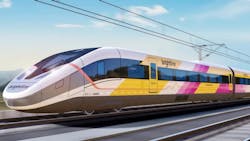U.S. High Speed Rail Coalition unveils roadmap with guidance on how to launch high-speed rail project
The U.S. High Speed Rail Coalition unveiled a roadmap with guidance on how to launch a high-speed rail project. The first-of-its-kind action plan is intended to equip advocates with practical tips, realistic expectations and strategic support as they work to launch new high-speed train projects in their regions.
“High-speed rail lines are complex megaprojects with unique challenges,” said Bernard Cohen, senior advisor for planning and operations at Alternate Concepts Inc., as well as former Massachusetts Department of Transportation secretary and the principal author of the roadmap. “We’ve created a practical guide that demystifies what’s involved in launching a new high-speed rail project.”
The report, “High-Speed Rail Projection Initiation: A Roadmap for Advocates”, focuses on five key building blocks of success:
- Organization
- Technical planning
- Strategic engagement
- Project funding
- Compelling communications
The report argues that long-term, strategic advocacy campaigns are required to launch new high-speed projects. When designing campaigns, advocates must be fully aware of potential pitfalls, as well as likely sources of support and opposition.
The roadmap notes that a recent survey by Public Policy Polling for the Coalition found that 72 percent of U.S. registered voters support the creation of a nationwide high-speed rail network in the U.S. According to Ezra Silk, political director of the U.S. High-Speed Rail Coalition, a major goal of the report is to help build a grassroots movement for a national high-speed rail network.
“Launching high-speed rail involves technical experts but you don’t need to be a transportation planner to take the lead in bringing high-speed rail to your community,” Silk said. “Millions of Americans want high-speed rail and this report will help give them the tools they need to turn their bullet train dreams into reality.”
The roadmap was designed by the International Association of Machinists and Aerospace Workers. In May, the 600,000-member union announced a voluntary recognition agreement with Siemens Mobility to represent workers who will build the trainsets for the Brightline West high-speed rail project that will connect Las Vegas, Nev., to southern California by 2028.
